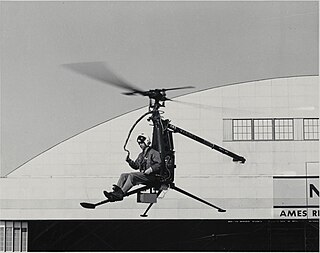The Lualdi-Tassotti ES 53 was an Italian experimental helicopter designed by Carlo Lualdi around a Hiller-designed rotor system and a gyro stabiliser of his own design. It first flew at Campoformido in September 1953.
The Aer Lualdi L.55 was a prototype Italian helicopter, a development of the Lualdi-Tassotti ES 53 featuring a far more powerful 134 kW (180 hp) Lycoming O-360. While the ES 53 had been purely experimental, the L.55 was Lualdi's first step towards a marketable aircraft.

The Mil Mi-6, given the article number izdeliye 50 and company designation V-6, is a Soviet/Russian heavy transport helicopter that was designed by the Mil design bureau. It was built in large numbers for both military and civil use and was the largest helicopter in production until the Mil Mi-26 was put in production in 1980.

The Aerotécnica AC-12Pepo is a Spanish two-seat light helicopter manufactured in 1956 by Aerotécnica.

The Agusta A.115 was a prototype helicopter flown in 1961 in Italy. It was essentially a Bell 47J-3 with an unclad, tubular tail boom, and powered by a Turbomeca Astazou II turboshaft engine. No production ensued.

The Agusta A.103 was an Italian prototype single-seat light helicopter flown in October 1959. The pilot was enclosed by a perspex bubble with the engine at the rear and the tail rotor carried on an enclosed boom.

The Agusta A.104 Helicar was an Italian prototype light commercial helicopter first flown in December 1960.

The Agusta AB.102 was an Italian helicopter produced in small numbers in the early 1960s. The aircraft was based on the mechanical components of a Bell 48 that Agusta incorporated into an all-new, streamlined fuselage. The first flight was on 3 February 1959 and the prototype was exhibited at that year's Paris Air Show in faux military colours. Only two production examples were built, operated by Elivie in a regular air service between Turin and Milan from 1961. However, the advent of turbine-powered helicopters in the 1960s soon rendered the AB.102 obsolete.

The BŻ-4 Żuk, formerly known as GIL-4, was a Polish four-seat light helicopter built in the 1950s. Although it pioneered a novel rotor and transmission system, it never entered series production.

The Bölkow Bo 103 was an ultralight experimental helicopter flown in West Germany in 1961. It was designed for reconnaissance and command-control purposes and constructed by Bölkow Entwicklungen KG as part of a research order by the German Federal Ministry of Defense.
The Manzolini Libellula was a 1950s Italian co-axial twin-rotor helicopter designed by Ettore Manzolini. "Libellula" is the Italian word for "Dragonfly".

The Doman LZ-5 was a utility helicopter developed in the United States in the early 1950s by Doman Helicopters Inc. of Danbury, Connecticut. Despite the procurement of international manufacturing agreements, no series production of the aircraft ever occurred, and only three prototypes were built. Two of these were purchased by the United States Army as the YH-31, but eventually becoming VH-31.
The Fiat Model 7002 was a 1960s Italian general-purpose helicopter with a tip jet driven rotor built by Fiat Aviazione. Only one aircraft was built.

The Gyrodyne RON Rotorcycle was a tiny, single-seat helicopter designed under contract for the United States Navy. in the mid-1950s. It later was redesigned for a U.S. Marine Corps requirement for a small personal helicopter that would fulfill a number of roles, including observation, liaison, small unit tactical maneuvers, and which could be dropped to downed airmen behind enemy lines to facilitate their escape.

The Hiller ROE Rotorcycle was a single-seat ultralight helicopter designed in 1953 for a military requirement. A total of 12 were produced for the United States Marine Corps. And in 1954, the Hiller Helicopters was selected by the US Navy's Bureau of Aeronautics to build this design of a one-man, foldable, self-rescue and observation helicopter. It featured a two-blade rotor system. Its original empty weight was 290 lb (132 kg).

The Cicaré CH-7 and Heli-Sport CH7 are a series of ultralight, kit-built helicopters based on a single-seat Argentinian design from the late 1980s. It was later developed into a tandem two-seater, and remains in production.

The Borgward BFK-1 Kolibri, a.k.a. Borgward-Focke BFK-1 Kolibri, was a German three-seated utility helicopter built by Borgward, designed by Heinrich Focke and was the first German helicopter after World War II. The helicopter first flew on 8 July 1958 in Bremen, piloted by Ewald Rohlfs.
The Goodyear GA-400R Gizmo was a one-man helicopter proposed for duties such as liaison and observation.
The Kinney HRH is an American helicopter that was designed by Robert Kinney and produced by Vortech, Inc in the form of plans for amateur construction. The aircraft was first shown at Sun 'n Fun in 2002.

The Vertical Hummingbird is an American helicopter, produced by Vertical Aviation Technologies of Sanford, Florida that was introduced in 1991. The aircraft is supplied as a kit for amateur construction.














